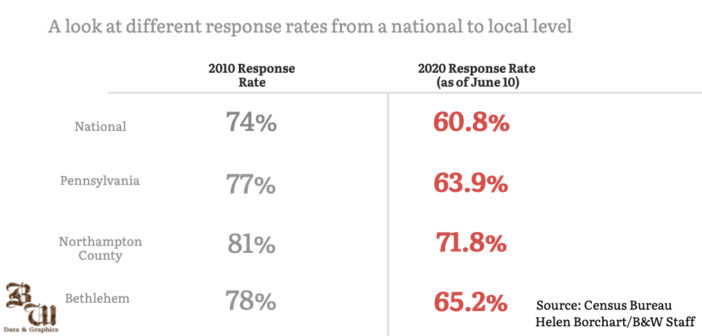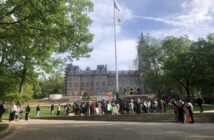Even with a backdrop of the coronavirus pandemic, a troubled economy and renewed attention to the issues of racial justice and police brutality, the 2020 Census is churning onward.
The constitutionally-mandated decennial counting of the country impacts the number of seats a state gets in the U.S. House of Representatives and can shift legislative borders at the state and federal levels. The Census also plays a role in directing hundreds of billions of dollars in federal funding to communities nationwide in areas like school lunch programs, highway construction, Head Start, hospitals and fire departments.
City, state and federal officials across Bethlehem and the Lehigh Valley are making a concerted push to make every resident count.
Stephanie Augello, the executive assistant to Bethlehem Mayor Robert Donchez, is the point person for Bethlehem’s Complete Counts committee. She said the city is taking the Census seriously. The committee, which has involved representatives from the school district, universities, hospitals, nonprofits, businesses and the housing authority, has met every three months starting over a year ago in May 2019 to prepare for the Census. Rep. Steven Samuelson (D., Northampton) was also involved in the committee to get the word out and reach the city’s “undercounted areas and residents who we felt would be more nervous” about filling out the Census.
Augello said the city’s efforts have been aided by Lehigh’s Community Service Office, which she said helped in distributing posters written in Spanish and English on the South Side, as well as a logo designed by a Freedom High School student encouraging Census participation.
Though it’s still early, so far Pennsylvania, Northampton County, Bethlehem and the 7th Congressional District are all recording higher response rates than the national average, according to the Census Bureau.
“We’re outpacing the state overall in terms of return of Census data, which is essential to getting the kinds of relief that those communities need,” said Rep. Susan Wild (D., Pa.) in a recent media town hall. “However, having said that, we’re still… not anywhere close to 100 percent.”
The national response rate, as of June 10, stands at 60.8 percent. Pennsylvania ranks 16th-best out of all U.S. states with a response rate of 63.9 percent. Northampton County’s response rate is 71.8 percent, Bethlehem stands at 65.2 percent and the 7th Congressional District, covering Lehigh and Northampton counties and parts of Monroe County, has recorded a 69.7 percent response rate.
In 2010, the Census Bureau reported a national response rate of 74 percent, matching that of 2000. Pennsylvania reported a 77 percent response rate, Northampton County finished at 81 percent and Bethlehem came in at 78 percent in 2010.
Although the numbers look promising, Augello said she has some concerns.
Augello said one of her biggest worries is people not filling out the Census based on concerns that their information is not safe or not adequately protected. She said vulnerable populations sometimes believe their information will be shared with other government agencies.
The Census Bureau, however, is legally bound to keep any respondents’ information confidential, and any identifiable information cannot be released — including to law enforcement or government agencies.
Other barriers arose, too. Augello said a political group sent out an illegitimate Census form this past February. She said the form looked almost identical to the Census and was labeled as a “2020 Congressional District Census.” Augello said the questions on this fake form were not the same as the Census, but the mailer was labeled “official document” and “do not destroy” like the Census.
She said if an individual filled out this fake form, it could potentially “confuse or trick” people into thinking they’ve completed the Census.
“That was something we were up against,” she said.
Another challenge included the national controversy over President Donald Trump’s suggestion of a citizenship question to appear on the Census. Even though the citizenship question ultimately did not make it onto the Census, the intent behind it created confusion and uncertainty, Augello said.
“The goal is to make sure everyone is accounted for.”
-Rep. Steve Samuelson (D., Northampton)
She said last year, random residents throughout the county were selected to receive a practice “2019 Census Test” form from the government, some of which did include the citizenship question as a sample. Concerned, some residents began calling Bethlehem’s Hispanic Center with questions.
“The Census became somewhat political at times, and people worried about another agenda going on with the citizenship question,” she said. “I think that citizenship question was a big issue.”
Augello, however, said she believes since the citizenship question was struck down by the Supreme Court in 2019, the city’s marketing campaign has been able to emphasize that any information shared on the Census is confidential and will not be shared.
Even though the Census has yet to send out its “Census takers” to interview residents at their homes if they have yet to fill out the Census — which will begin in July — both Augello and Samuelson said Bethlehem’s South Side is already emerging as an area of greater focus.
According to the latest Small Area Income and Poverty Estimates in 2018, 16.2 percent of families with children aged 5 to 17 enrolled in the Bethlehem Area School District were considered poor. That’s higher than both the poverty rate for the same age group and the general poverty rate of Northampton County, which are at 13.5 percent and 10.2 percent, respectively.
“We have lower rates of response in certain neighborhoods, neighborhoods where there’s more apartments,” Samuelson said. “You find that in South Side Bethlehem, where the response rate is lower than the city-wide average, it’s in the 40s at this point. That’s a target of the outreach.”
Samuelson said the Census itself does an estimate, showing that each person counted could mean a difference of $2,000 in funding for a given municipality. Even a 90 percent response rate for Bethlehem’s 75,000 population means about 7,500 people aren’t counted — and potentially thousands of dollars diverted elsewhere that the city is entitled to.
“The goal is to make sure everyone is accounted for,” he said. “It’s so important that everybody responds because there’s a lot of funding that’s tied to population.”






Comment policy
Comments posted to The Brown and White website are reviewed by a moderator before being approved. Incendiary speech or harassing language, including comments targeted at individuals, may be deemed unacceptable and not published. Spam and other soliciting will also be declined.
The Brown and White also reserves the right to not publish entirely anonymous comments.